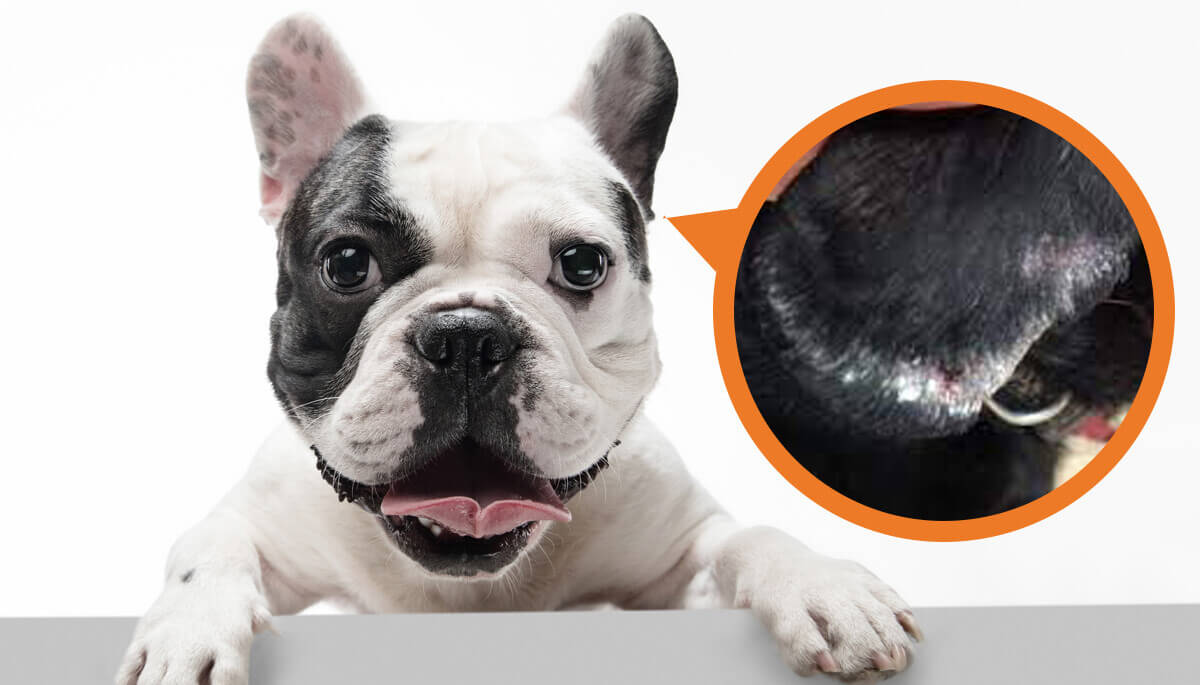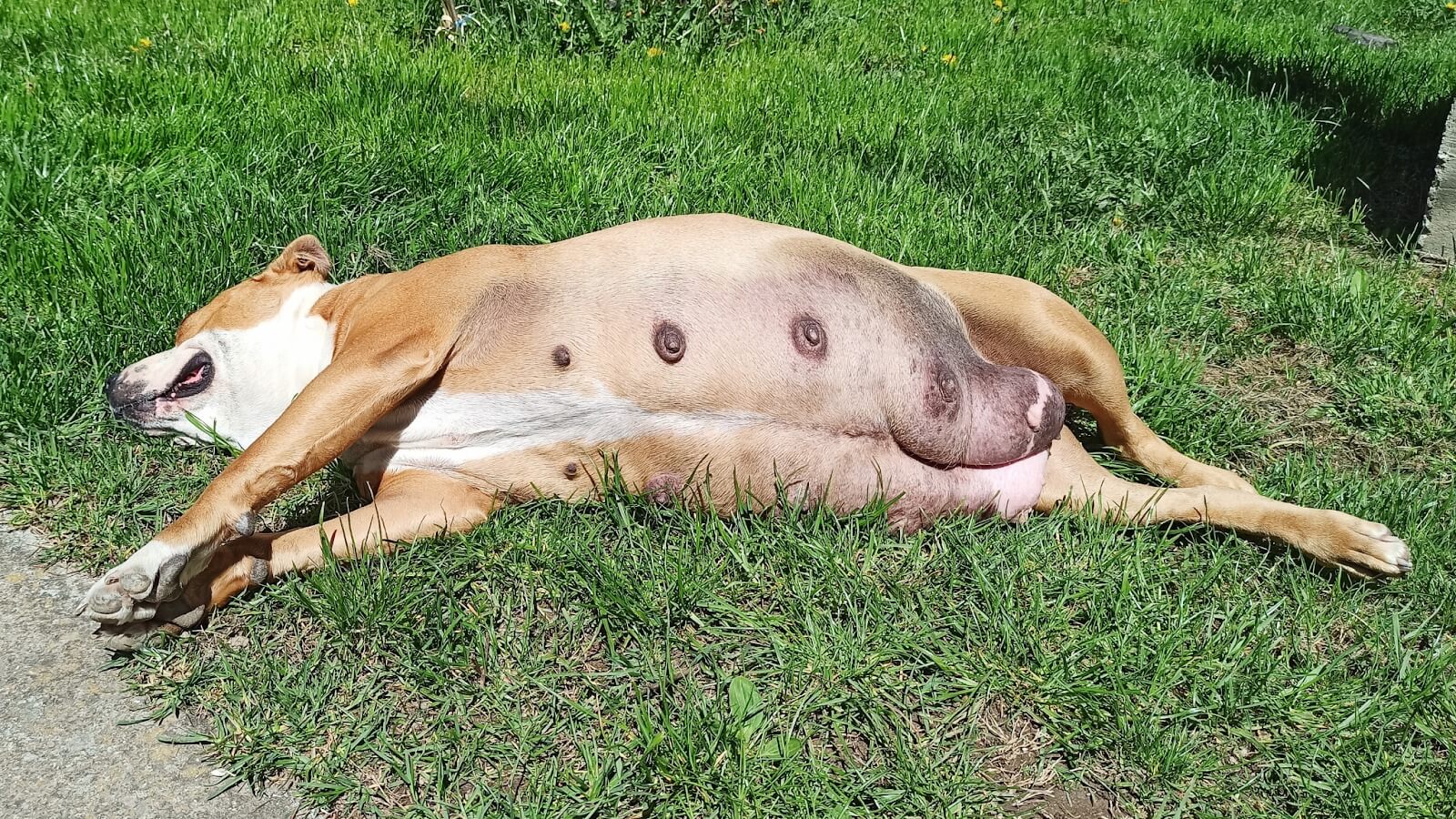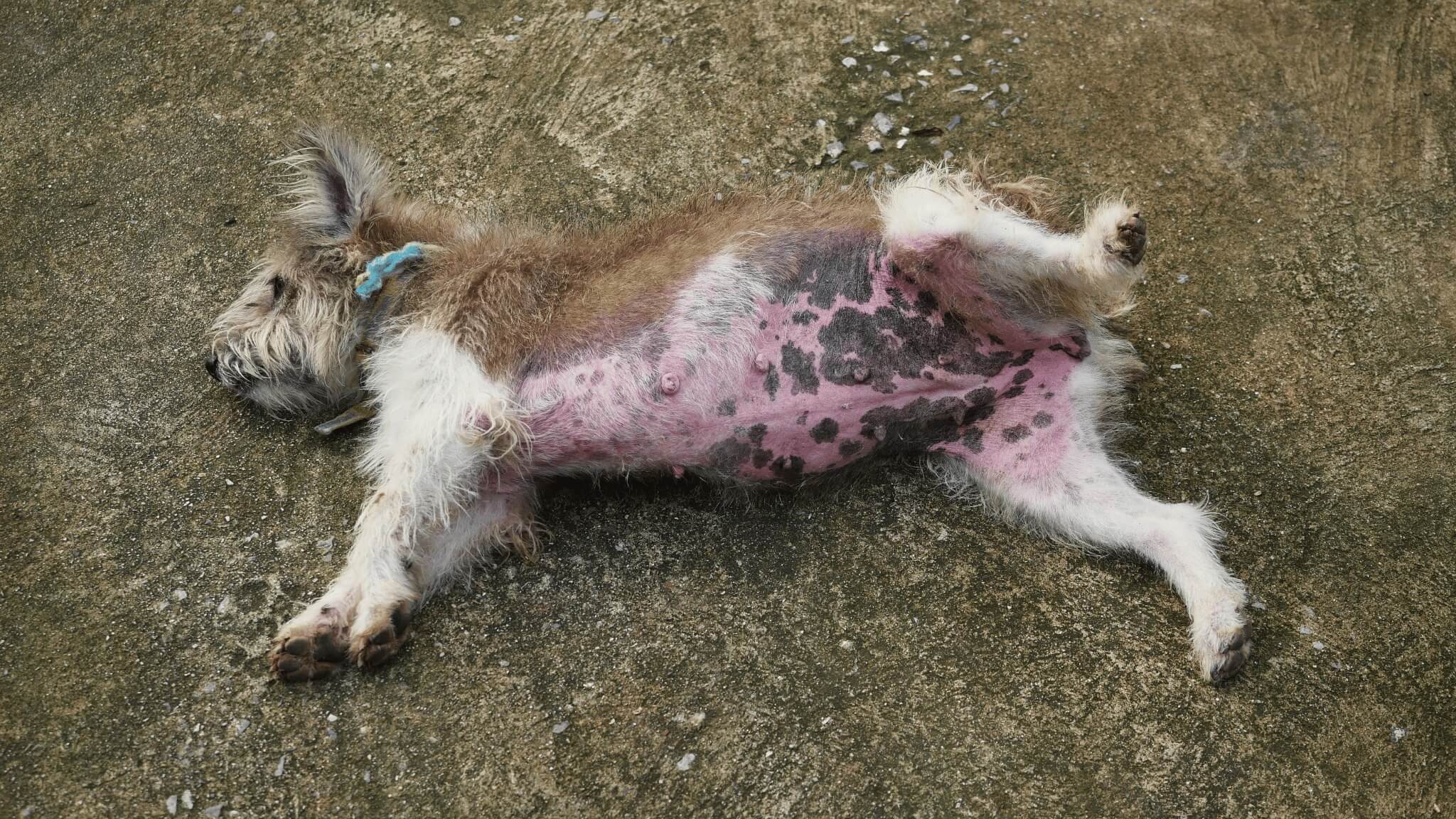If you see thick crusty scabs on the edges of a dog’s ears, the problem is likely ear edge dermatitis. Dermatitis simply means the skin becomes red, inflamed, and sometimes itchy. It creates sores or lesions that eventually become scabs. This condition can lead to hyperkeratoses in on edges of the ear or ear margins, which means the skin gets tougher and thicker, in addition to becoming oily and crusty.
Of course, the most common issue we deal with in our dogs are the dreaded ear infections in the ear canal. This is why we use dog ear-cleaning wipes to clean out discharge to help avoid fungal and bacterial infections.
However, black or brown scabs on the edges of a dog’s ear are usually symptoms of severe ear problems that need veterinary attention. So let’s look what the BSAVA Book on canine dermatology has to say about what ear scabs on your dog may mean.
So, What Do Scabs on the Edge of a Dog’s Ears Mean?
Scabs on a dog’s ear edges usually indicate ear edge dermatitis, stemming from immune issues, scabies, frostbite, etc. You may also see hyperkeratinization, which means the skin gets thicker in that area. A lone scab could signify an injury, possibly from dogs biting each other’s ears, or potentially denote a carcinoma. Always consult a vet for a proper diagnosis and treatment plan.
Dog ear edge dermatitis is also called:
- Dog ear margin dermatoses; or
- Dog ear edge seborrhea
This condition is most common in Dachshunds, but can affect any breed, particularly those with long ears. Some sources call it dog ear edge hyperkeratinization, but hyperkeratinization is really only one of the symptoms.
Remember, never pick the scabs off a dog’s ear.
Understanding Ear Margin Dermatosis in Dogs
Symptoms of Dog Ear Dermatitis:
- Scaly Skin: Owners may observe varying amounts of scaly skin along the edges of the ears.
- Hair Loss: Loss of hair around the affected area is a common symptom.
- Seborrhea: The skin on the ear edges may appear greasy or exhibit dry, flaky skin.
- Crusts or Scabs: The presence of crusts or scabs is a frequent indication.
- Open Sores and Dead Tissue: Severely affected areas may have open sores and dead tissue.
- Follicular Casts: These are accumulations or plugs of skin debris and around the hair shaft visible on the ear edges. You should be able to gently pull these plugs of hair and gunk on the edges out.
- Non-Inflamed Skin: The skin underneath typically does not appear inflamed or infected.
Advanced Symptoms:
If the condition develops into hyperkeratoses, you might notice:
- Yellow or gray, waxy crusts at the base of the hair on the edges of the ears.
- The skin becoming thicker around the ear edges
- Hair in affected areas is easy to pull out, leaving shiny skin behind.
- Presence of lesions, greasiness, and thick waxy plugs along the end of the ear.
- The dog might also shake their head frequently due to discomfort.
Considerations:
- In cases of severe itching, consider sarcoptic mange.
- For severe crusting, ulceration, or fissures, vasculitis could be a concern, and a biopsy might be necessary.
There are many possible causes of dog ear edge dermatitis. If your dog shows the symptoms listed above, look out for these underlying causes:
8 Possible Causes of Dog Ear Margin Dermatitis
Dog ear dermatitis is not the only reason your dog may have scabs on the outer edge of the ear flaps (pinna). Here are several other reasons to look out for.
1. Scabies
Scabies is highly infectious mites your dog can pick up in dog parks or other places where there may be a lot of other dogs. They usually infect the edges of the ears, elbows, and belly. You should see a lot of itching and hair loss.
2. Fly strike
Fly strike can cause hairless patches with red, black, or brown scabs, often around the edges of the ears. It usually affects dogs that live outdoors in warm weather. It’s caused by biting flies like horse flies or biting gnats.
To prevent this, see our articles on how to keep flies off dogs and how to keep gnats off dogs.
3. Zinc Responsive Dermatoses
When it comes to large breeds, particularly Nordic breeds like Huskies and Malamutes, you may find that zinc deficiencies cause crusty ears, mouths, eyes, noses, and private parts. You will usually see a lot of hair loss, lesions, scales, and crusts.
4. Autoimmune diseases
Autoimmune diseases like lupus or cellulitis often cause skin problems in dogs, ranging from brown spots of hyperpigmentation to dry paws or even peeling nails. But two specific immune problems are most likely to lead to crusty scabs on the edge of a dog’s ears.
Vasculitis
Ear edge vasculitis starts with smudgy, black, or brown marks along the edges of the ear flap. You will then see hair loss and dead tissue. The lesions “punch out” holes on the end of the ears. Dachshunds and Chihuahuas are most at risk.
Pemphigus
There are different types of pemphigus. But pemphigus foliaceous creates pimples on a dog’s face that burst and make yellow crusts or scabs. It usually starts around the nose, muzzle, eyelids, and ears.
5. Underlying Hormonal Problems
Endocrine disorders like Cushing’s disease often affect a dog’s skin and coat. But if you find scabs on your dog’s ears, your vet may need to test for hypothyroidism or seasonal, light-responsive alopecia.
You may see oily, greasy skin or dry flakes with both conditions and hair loss. This is seborrhea, and since it can lead to inflamed pustules and folliculitis, it can also cause scabs.
A blood test will show if a dog has a thyroid or adrenal problem. If the hair loss is symmetrical, and you live in the Midwest, it may be light-responsive alopecia. This sometimes shows up in breeds like Labradors, Dobermans, Bull Dogs, and Boxers.
6. Allergies
It won’t be a skin problem if an allergic reaction isn’t a possible cause. Specific breeds, like Labradors and Boxers, can get scabby ear edges from allergies. This will look like scabies, so if the vet rules out scabies, then atopic dermatitis may be the reason.
7. Seborrhea
Yeast or other fungal infections or a keratin disorder in the skin follicles sometimes causes seborrhea, which may cause scabby ears edges. It will also often affect the nose. Sometimes this can be treated with vitamin A supplements.
Once again, it’s Dachshunds that are most likely to have yeast ear dermatitis, but it also happens in Yorkshire Terriers.
8. Other possible causes of scabs on the edges of a dog’s ear
If none of the causes above apply, you may need to look at the following:
- Frostbite;
- Ringworm;
- Cold agglutinin disease;
- Skin cancer; and
- Injuries.
If you notice a scab or wound that never seems to heal, your vet may need to remove it in case of cancer.
How do I get rid of my dog’s ear edge dermatitis?
Getting rid of scabs on a dog’s ear means determining the cause. If the scab is from an injury, remember never to pick it off or let your dog scratch it. Damage to the skin can cause secondary bacterial or fungal infections.
While many dogs with dog ear dermatitis may not show signs of discomfort, proper management is crucial if symptoms progress. Over-treatment could potentially worsen the condition. Mild cases may not require treatment, but advanced cases, especially those causing discomfort, may necessitate management like the removal of scales and hair casts and the application of topical treatments.
If the scab is rubbed off, you will need to stop the bleeding first by applying pressure.
You can read more in our article on how to stop a dog’s ear bleeding.
You can also see this video on how to bandage a dog ear tip:
You must take your dog to a vet if the scabs are not from a minor injury. Do not try to use natural home remedies because you need to have the cause accurately diagnosed and have your vet determine the correct course of treatment.
Remember, ear edge dermatitis has many causes, so there is no singular treatment.
For instance, scabies is highly contagious, and without veterinary intervention, they can spread quickly to other dogs and the rest of the body. If your dog has an immune or endocrine disorder, they will need hormonal treatments or immuno-suppressive drugs.
One thing you can do at home to help your dog if they have skin problems is to address their nutrition. But this also comes with a warning.
Using nutritional and diet to help fight scabs on the edge of dog’s ears
Good nutrition is unquestionably one of the strongest weapons we have when dealing with any skin condition. But the key is: don’t go it alone. A dog’s diet needs to be carefully balanced by a professional; owners can sometimes make deadly mistakes with the best intentions.
For example, some nutrients interfere with the absorption of others. Calcium and phosphorus are essential to any dog’s diet, but they can bind with zinc in the stomach and prevent it from being absorbed and causing dermatoses. But if you try to supplement your dog with extra zinc, you may cause zinc toxicity unwittingly.
Likewise, it’s common practice to improve a dog’s skin condition with essential omega-3 fatty acids from fish oil, and vitamin A can help ear-end dermatitis conditions too. This may lead owners to supply their dogs with cod liver oil. However, cod liver oil is so high in vitamins A (and D) that it can build up in a dog’s system and cause vitamin A toxicosis.
So yes, a good diet with more essential fatty acids and zinc can help boost your dog’s immune system and improve conditions that cause scabs. But a dog’s diet still needs to be properly balanced by a professional.
How do you treat ear margin hyperkeratosis?
In the case of hyperkeratinization, your vet needs to examine your dog and rule out other possible skin problems. They will also check for secondary infections and run a cytology test.
Treating ear margin hyperkeratinization usually means regular washes with shampoos for seborrhea. These typically have salicylic acid, sulfur, or benzoyl peroxide, and moisturizer. They may also supplement a dog’s diet with omega fatty acids and vitamin A.
If there is a lot inflammation, they may give your a topical steroidal cream.
Final Thoughts
Scabs on the edge of a dog’s ear can be from an injury, and occasionally, it may be a carcinoma. In certain breeds, like Dachshunds, it can be a keratinization disorder. However, most of the time, it’s a type of ear-end dermatitis.
There are multiple causes of this inflammation and irritation of the ear flaps. A vet will need to determine if its allergies, endocrine or immune disorders, fly strike, scabies, or many other possibilities.









